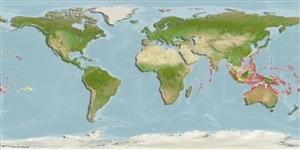Common names from other countries
>
Eupercaria/misc (Various families in series Eupercaria) >
Scaridae (Parrotfishes) > Scarinae
Etymology: Scarus: Greek, skaros = a fish described by anciente writers as a parrot fish; 1601 (Ref. 45335).
More on author: Valenciennes.
Environment: milieu / climate zone / depth range / distribution range
Ecología
marino asociado a arrecife; rango de profundidad 0 - 20 m (Ref. 90102). Tropical; 32°N - 27°S, 57°E - 141°W
Indo-Pacific: Mauritius (Ref. 5503) to the Line and Tuamoto islands, north to the Ryukyu Islands, south to Shark Bay and the Great Barrier Reef.
Tamaño / Peso / Age
Maturity: Lm ? range ? - ? cm
Max length : 44.5 cm TL macho / no sexado; (Ref. 125599); peso máximo publicado: 2.1 kg (Ref. 125599)
Espinas dorsales (total): 9; Radios blandos dorsales (total): 10; Espinas anales 3; Radios blandos anales: 9. Males recognized by the dark area over head and body, and females yellow barring (Ref. 48636). Closely resembles S. dimidiatus, but S. oviceps differs in that its initial phase has fewer, less vertical diagonal black bars on the back and the terminal phase lacks the light-centered bar between the eye and the pectoral fin base, is darker and less brilliant blue on the upper head and back and is usually larger.
Inhabits lagoon and seaward reefs to at least 10 m (Ref. 9710, 48636). Also found in lagoons and coastal and outer reefs to 20 m deep (Ref. 90102). Feeds on benthic algae (Ref. 89972). Occurs singly (Ref. 4821). May also form groups (Ref. 90102). Minimum depth reported taken from Ref. 128797.
Life cycle and mating behavior
Madurez | Reproducción | Puesta | Huevos | Fecundidad | Larva
Oviparous, distinct pairing during breeding (Ref. 205).
Randall, J.E., G.R. Allen and R.C. Steene, 1990. Fishes of the Great Barrier Reef and Coral Sea. University of Hawaii Press, Honolulu, Hawaii. 506 p. (Ref. 2334)
IUCN Red List Status (Ref. 130435)
CITES (Ref. 128078)
Not Evaluated
Threat to humans
Harmless
Human uses
Pesquerías: comercial; Acuario: Comercial
Más información
ReferenciasAcuiculturaPerfil de acuiculturaRazasGenéticaElectrophoresesheritabilidadEnfermedadesProcesamientoMass conversion
Herramientas
Special reports
Download XML
Fuentes de Internet
Estimates based on models
Preferred temperature (Ref.
115969): 25 - 29.3, mean 28.4 (based on 2163 cells).
Phylogenetic diversity index (Ref.
82804): PD
50 = 0.5000 [Uniqueness, from 0.5 = low to 2.0 = high].
Bayesian length-weight: a=0.01096 (0.00670 - 0.01793), b=3.13 (2.99 - 3.27), in cm Total Length, based on LWR estimates for this species & Genus-body shape (Ref.
93245).
Nivel trófico (Ref.
69278): 2.0 ±0.0 se; based on diet studies.
Resiliencia (Ref.
120179): Medio, población duplicada en un tiempo mínimo de 1.4-4.4 años (Preliminary K or Fecundity.).
Fishing Vulnerability (Ref.
59153): Low to moderate vulnerability (35 of 100).
